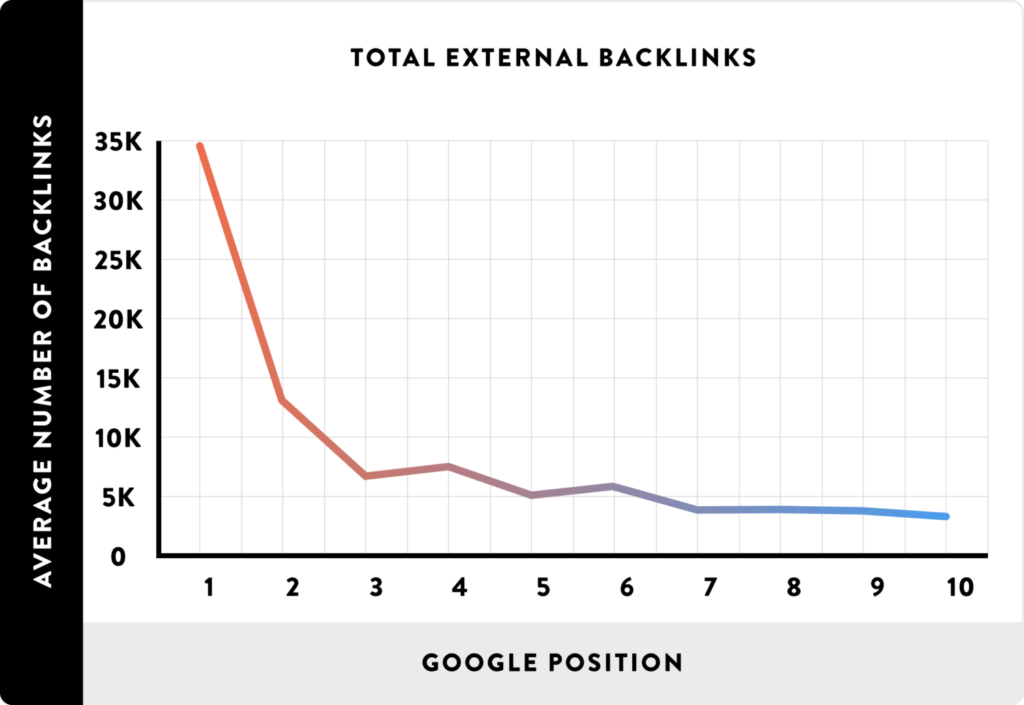Published on 5 October 2018 (Updated 29 February 2024)
It’s no secret that if you want to please Google, backlinks must be integral to your SEO strategy. In this guide, we will present you with different techniques to get quality backlinks to improve your SEO.
Definition of a backlink
A backlink is a link from a website pointing to yours. It is also called an incoming link, and we use the term Netlinking strategy to improve the number of links pointing to your site.
Today, they are considered essential to improve your natural referencing. Google has confirmed that backlinks are part of the main criteria determining your positioning on search results. These links are considered as “votes” by Google and allow it to ensure the quality of your content.
A recent study confirms their importance by showing the relationship between the number of incoming links and the positioning in search results.

There is a clear relationship between the number of incoming links and the positioning on Google
But be careful, not every link is good to take, Google takes into account different factors to judge the relevance of your backlinks.
So, what is a quality backlink?
What is a quality backlink?
Quality and diversification
One might think having the most backlinks is enough to convince Google, but that would be too easy.
Two criteria should be taken into account:
- The reputation of the domain where the link comes from
- The diversification of the sites pointing to your site
For example, let’s take a link from Forbes magazine and a link from a “lambda” site. The link from the Forbes site will have a much greater weight than the other site because it has a better reputation, and Google knows how to determine this.
Note: SEO tools like Ahref or Moz (free), allow you to analyze the sites where your backlinks come from and identify their domain reputation.
Next, it is important to diversify the sites pointing to your site. Which is to say it is better to have 10 links from 10 different sites than 10 links from one site.
Optimize the anchor text
Optimizing the anchor text is essential for both your SEO and your reader.
Avoid the “for more information, click here” type of links
Try to enrich the anchor text so that the content of the landing page is understood in one sentence.
For example, “it’s important to learn about SEO for…” is a rich anchor text.
Be careful not to over-optimize the anchor text and not to abuse it, because Google may consider these optimizations as spam.
The theme of the sites
It’s simple, Google prefers a link coming from a site related to your sector, your niche, than a link coming from a site that has nothing to do with your business. This criterion is understandable in the sense that Google may consider sites with a similar niche as more likely to judge the content of your site.
For example, a link from a blog about cats pointing to our blog will have a minor impact compared to a link about web marketing.
What kind of content to produce to obtain backlinks?
If you want to get inbound links to your site, you must produce quality content to convince your audience to share it. You have different options to achieve this:
Infographics
An infographic is a set of statistics on a specific subject/area presented as an image. Its content is often relevant, its format highly graphic and pleasant to read.
This type of content generates a lot of engagement, especially on social networks.

Discover our Infographic on the ChatBot Messenger Trend
Guide
Guides are very long articles that aim to cover a large part of the questions that can be asked on a specific subject. They can be compared to white papers.
Case study
Depending on your business, a case study can be very relevant to your readers. They allow you to put into practice “theoretical” content that you could have done before (like a Guide).
Accompanied by testimonials, they can also reassure your potential prospects who might call on your services.
News
Internet users are fond of this type of content. An article on the news of your niche in a ranking format
(example: Top 10 News about xxx of the week) will generate engagement quickly and can get you new backlinks.
Guest article
Guest articles are a must in netlinking strategies. The principle is simple: write an article on a specific subject and then ask an influential blog to post it on its site. This is an opportunity to include an outbound link to your site.
The blog ends up with free and qualitative content to share, and you will gain the backlinks you want.
Tip: you can also do a Guestographic by sending an infographic!
Our tips and tricks to get new backlinks
Having a content strategy is an important step to get inbound links, but you can do better if you want a rapid growth of the number of backlinks to your site.
The idea is to seek and identify opportunities to get new links pointing to your site.
For this, several solutions are available:
Analyze the competition
What can be better than looking at your competitors to identify opportunities for Backlinks? As mentioned at the beginning of this guide, tools like Ahref or Moz allow you not only to see and analyze your own backlinks but also those of your competitors’!
What to do with this information?
Your mission will be to identify the possibilities of improvement of content where the competitors are quoted to steal a Backlink from them! To do this, contact the site in question and propose an improved version of the content of your competitor or just a complementary version if you only want to get an incoming link to your site.
Mention Influencers in your posts and contact them
It’s simple and effective. Don’t hesitate to identify an influencer in your articles (if it’s relevant) and contact them by telling them that you have mentioned them in your posts. If everything goes well, the influencer will share your article on social networks and generate backlinks and traffic!
Make an interview or a Podcast
Audio content is becoming more and more popular on the internet. If you are an expert in a field, you can get interviewed and get a backlink once the interview is shared. If you participate in a conference, chances are that influential blogs will identify you on their articles as well.
Claim your links
It’s common for your content to be used in articles other than your own without being cited as the source of that content (unfortunately, the world isn’t perfect). You can then kindly contact the site in question and ask them to link to your site.
Tip: Do you create infographics? Use Google’s image search to identify sites that use your infographic without citing you.

WHAT ARE YOU WAITING FOR?
All the cards are now in your hands to build your netlinking strategy. However, if you’d like us to help you with your SEO strategy, don’t hesitate to contact our team.





